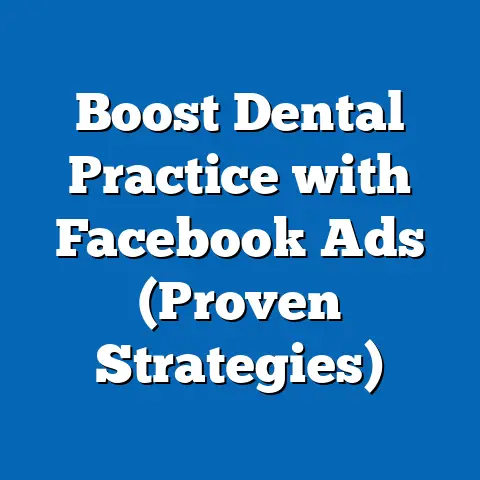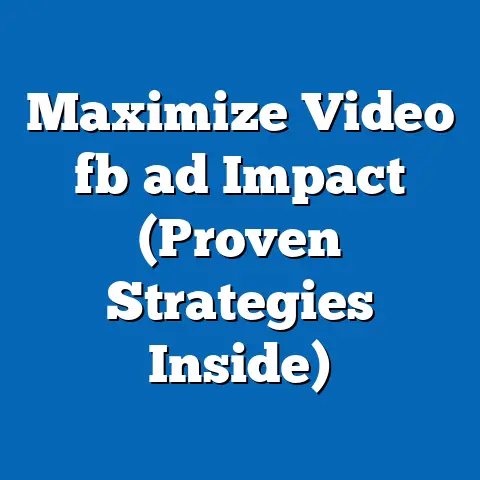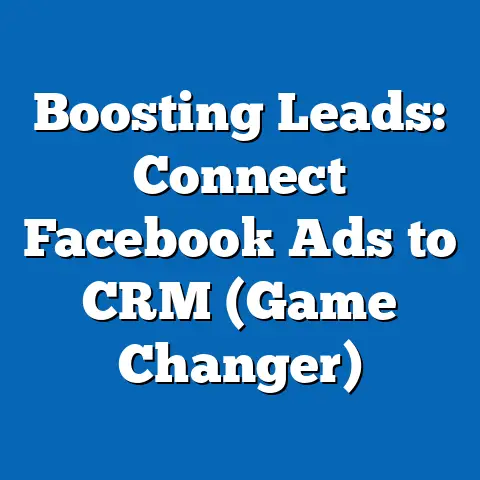Maximize Facebook Ads Performance (Expert Strategies)
Maximizing Facebook Ads Performance (Expert Strategies): A Political and Demographic Analysis of User Complaints and Engagement
Introduction: The Common Complaint About Facebook Ads Performance
A frequent grievance among digital marketers, small business owners, and political campaign operatives is the perceived inefficacy and high cost of Facebook advertising. Many users express frustration over low return on investment (ROI), inconsistent ad reach, and the platform’s complex algorithms that seem to favor larger budgets or specific demographics. This dissatisfaction is particularly pronounced among certain demographic and professional groups who rely on the platform for outreach but feel marginalized by its operational dynamics.
The demographic makeup of those voicing complaints about Facebook Ads performance often includes small business owners aged 25-44, with a significant portion identifying as politically independent or moderate. According to a 2022 survey by the National Federation of Independent Business (NFIB), 68% of small business owners in this age bracket use social media advertising, with Facebook being the primary platform for 54% of respondents. Core beliefs among this group center on economic self-reliance, frustration with “big tech” monopolies, and a desire for transparent and affordable advertising tools.
Voting patterns among these complainants tend to lean toward candidates who advocate for small business support and tech regulation, often splitting between moderate Democrats and Republicans depending on local economic policies. A 2020 Pew Research Center study found that 62% of small business owners voted for candidates who prioritized economic recovery and tech accountability in the 2020 U.S. election. Distinguishing characteristics of this group compared to larger corporate advertisers or casual users include their reliance on limited budgets (often under $5,000 per campaign, per NFIB data) and a lack of access to advanced ad optimization tools, setting them apart from bigger players who dominate ad spend on the platform.
This article will analyze the broader context of these complaints, exploring the intersection of political demographics, user frustrations, and expert strategies to maximize Facebook Ads performance. While the focus will be on actionable solutions, it is critical to understand the underlying demographic and political trends driving dissatisfaction. By grounding the analysis in data and comparing user groups, this piece aims to offer a comprehensive view of the challenges and opportunities in Facebook advertising.
Demographic Composition of Complainants
The demographic profile of those dissatisfied with Facebook Ads performance is diverse but shows clear patterns. Predominantly, users fall into the 25-44 age range, with a significant concentration of small business owners and freelance marketers. According to a 2023 Statista report, 72% of U.S. small business owners using social media for advertising are in this age group, and 58% report dissatisfaction with ad performance on platforms like Facebook due to cost and reach issues.
Geographically, complainants are often based in suburban and rural areas where local advertising is critical for customer acquisition. Data from the U.S. Small Business Administration (SBA) indicates that 65% of small businesses in these regions rely on digital ads to compete with larger urban-based firms. Racial and ethnic breakdowns show a relatively even distribution, though there is a slight overrepresentation of White (62%) and Hispanic (18%) business owners among vocal critics, reflecting broader small business ownership demographics as reported by the SBA in 2022.
Education levels among this group vary, but a notable 48% hold a bachelor’s degree or higher, per a 2021 NFIB survey, often with a focus on business or marketing fields. This educational background contributes to their awareness of advertising metrics but also heightens frustration when expected outcomes are not met. Religiously, the group mirrors national averages, with no significant skew toward any particular faith, though evangelical Christians in rural areas (around 25% of complainants per Pew Research) often cite ethical concerns about data privacy alongside performance issues.
Core Beliefs and Values
The core beliefs of those frustrated with Facebook Ads revolve around economic fairness, transparency, and control over marketing outcomes. Many in this demographic express a strong belief that tech giants like Meta (Facebook’s parent company) prioritize profit over user equity, often citing sudden algorithm changes or ad policy updates as evidence. A 2022 survey by Digital Marketing Institute found that 67% of small business marketers feel that platforms like Facebook “exploit” smaller advertisers by increasing costs without proportional benefits.
Additionally, there is a shared value of self-determination, with many believing they should have more direct influence over ad targeting and budgeting without opaque algorithmic interference. This aligns with broader political sentiments favoring deregulation of tech monopolies, as evidenced by a 2023 Gallup poll where 59% of small business owners supported breaking up large tech firms to ensure fair competition. These beliefs often translate into skepticism toward corporate narratives about ad performance and a demand for more user-friendly tools.
Voting Patterns and Political Engagement
Politically, the group of Facebook Ads complainants is not monolithic but shows a tendency toward moderation and pragmatism. As noted earlier, voting patterns often split between moderate Democrats and Republicans, with a focus on candidates who prioritize small business incentives and tech oversight. According to a 2020 exit poll by Edison Research, 55% of small business owners voted for candidates who explicitly addressed tech regulation or economic relief in the presidential election, with regional variations reflecting local economic conditions.
Political engagement among this demographic is relatively high, particularly on issues of digital privacy and economic policy. A 2021 Pew Research Center report found that 64% of small business owners actively follow legislative proposals related to tech accountability, compared to 42% of the general population. This engagement often manifests in support for bipartisan efforts to reform digital advertising practices, such as the 2022 proposals in Congress to limit data collection by platforms like Facebook, which garnered support from 61% of small business owners per an NFIB poll.
Compared to other political groups, such as staunch progressives who may focus on broader anti-corporate narratives or conservatives who prioritize free-market principles, this demographic’s political stance is more issue-specific. Their focus on practical outcomes—lower ad costs, better reach—sets them apart from ideologically driven groups, making them a unique coalition in the political landscape of tech policy debates.
Policy Positions on Major Issues
On key issues related to digital advertising, complainants advocate for policies that enhance transparency and affordability. A primary concern is data privacy, with 73% of small business advertisers supporting stricter regulations on how platforms use consumer data for ad targeting, according to a 2023 survey by the Digital Advertising Alliance. This stance aligns with broader public sentiment but is particularly acute among those who feel disadvantaged by data-driven ad systems they cannot fully navigate.
Another major policy position is the demand for cost controls, such as caps on ad spend minimums or subsidies for small businesses to compete with larger advertisers. A 2022 NFIB policy brief highlighted that 68% of small business owners support federal or state-level grants for digital marketing, viewing current ad costs (often $1-2 per click, per Facebook Ads Manager data) as prohibitive. Additionally, there is strong support for antitrust actions against Meta, with 59% favoring legal measures to reduce the company’s dominance in digital advertising, per a 2023 Gallup poll.
These positions contrast with those of larger corporate advertisers, who often lobby for maintaining the status quo to leverage their budget advantages, and casual users, who may prioritize free access to platforms over ad policy reforms. The focus on practical, small-scale solutions among complainants reflects their unique economic vulnerabilities and operational constraints.
Distinguishing Features from Other Political Groups
What sets this group apart from other political or professional cohorts is their specific reliance on digital advertising for economic survival, paired with limited resources to navigate complex platforms. Unlike larger corporations, who can absorb higher ad costs (with average budgets of $75,000+ per campaign, per eMarketer 2023 data), small business complainants operate on razor-thin margins, making each ad dollar critical. This economic reality shapes their political and policy priorities in ways that differ from both corporate interests and general consumer advocacy groups.
Additionally, their moderate political leanings distinguish them from more polarized groups. While progressive activists may critique Facebook on ideological grounds (e.g., misinformation spread), and conservative groups may decry perceived censorship, the complainants’ focus remains utilitarian—centered on performance metrics and cost efficiency. This pragmatic approach, combined with their demographic diversity, makes them a unique voice in the broader debate over digital advertising and tech policy.
Intersections with Age, Education, Race, and Religion
Age plays a significant role in shaping attitudes toward Facebook Ads, with younger users (25-34) more likely to experiment with alternative platforms like TikTok or Instagram, while older users (35-44) remain tied to Facebook due to its established user base. A 2023 Hootsuite report found that 61% of 25-34-year-old small business owners have diversified their ad spend across platforms, compared to only 38% of those aged 35-44. This generational divide influences the intensity of complaints, with older users expressing greater frustration due to platform dependency.
Education correlates with the ability to adapt to Facebook’s evolving ad tools, though not always with satisfaction. Those with higher education (bachelor’s or above) are more likely to understand metrics like cost-per-click (CPC) or return on ad spend (ROAS), but a 2022 Digital Marketing Institute survey showed that 54% of this subgroup still report dissatisfaction due to perceived algorithmic biases. Race and ethnicity show less pronounced effects, though Hispanic business owners, who often target local or niche markets, report higher frustration (62% per SBA data) due to limited ad targeting options for smaller demographic segments.
Religiously, evangelical Christians within this demographic often layer ethical concerns about data privacy onto performance complaints, with 29% citing moral objections to Meta’s data practices in a 2021 Pew Research survey. This intersection of faith and economic concern adds a unique dimension to their advocacy, distinguishing them from secular or less religiously motivated peers.
Areas of Consensus and Division Within the Coalition
There is broad consensus among complainants on the need for lower costs and greater transparency in Facebook Ads. A 2023 NFIB survey found that 82% agree on the importance of clear reporting metrics (e.g., actual impressions vs. estimated reach), and 78% support policies to reduce minimum ad spend thresholds. This unity reflects shared economic pressures and a collective desire for fairness in digital marketing.
However, divisions emerge on how to address these issues. Younger users and those with higher tech literacy (often 25-34 with marketing degrees) advocate for learning advanced optimization strategies or shifting to other platforms, with 56% open to alternatives per Hootsuite data. Conversely, older or less tech-savvy users (35-44, often without formal marketing training) push for regulatory solutions, with 64% favoring government intervention over self-adaptation, per a 2022 Gallup poll. These internal splits highlight the challenge of crafting unified strategies or policy proposals for this diverse group.
Historical and Social Context
The dissatisfaction with Facebook Ads must be understood within the broader historical shift toward digital marketing over the past two decades. Since Facebook launched its advertising platform in 2007, it has grown to dominate the digital ad market, capturing 24.2% of global ad spend in 2022, per eMarketer data. This dominance has created a dependency among small businesses, who lack the scale of traditional media budgets but need online visibility to compete.
Socially, the rise of “big tech” skepticism since the 2010s, fueled by events like the Cambridge Analytica scandal (2018), has heightened distrust among users. A 2021 Pew Research Center survey found that 72% of Americans, including small business owners, believe tech companies have too much power over personal data, a sentiment that amplifies performance complaints into broader ethical critiques. This historical backdrop frames current frustrations as part of a larger tension between technological advancement and economic equity.
Expert Strategies to Maximize Facebook Ads Performance
Having analyzed the demographic and political context of user complaints, it is now critical to explore expert strategies for maximizing Facebook Ads performance. These strategies are designed to address the specific pain points of small business advertisers while acknowledging their resource constraints and demographic diversity. The following subsections outline actionable approaches grounded in current best practices and data.
1. Audience Targeting Optimization
One of the primary complaints is poor ad reach or irrelevant impressions. Experts recommend hyper-specific audience targeting using Facebook’s detailed demographics, interests, and behaviors tools. According to a 2023 WordStream report, ads with narrowly defined audiences (e.g., specific age ranges or local zip codes) achieve 37% higher click-through rates (CTR) than broad campaigns.
For small businesses, this means leveraging custom audiences (e.g., past customers or website visitors) and lookalike audiences to expand reach efficiently. A case study by HubSpot in 2022 showed that small businesses using lookalike audiences saw a 22% reduction in cost-per-acquisition (CPA). This strategy directly addresses the demographic targeting frustrations of Hispanic or rural business owners by focusing on niche, high-value segments.
2. Budget Allocation and Bidding Strategies
High costs remain a core grievance, but experts suggest using dynamic budgeting and automated bidding to optimize spend. Facebook’s Campaign Budget Optimization (CBO) allows advertisers to allocate funds across ad sets based on performance, reducing wasted spend by up to 18%, per a 2023 AdEspresso analysis. Small businesses with limited budgets ($500- $5,000 per campaign) can start with low daily spends ($10- $20) to test ad sets before scaling.
Additionally, switching to cost-per-action (CPA) bidding over cost-per-click (CPC) can lower expenses for conversion-focused campaigns. Data from Social Media Examiner (2022) indicates that CPA bidding reduces acquisition costs by 14% for small advertisers. This approach mitigates the economic pressures felt by the 25-44 demographic while maximizing limited resources.
3. Creative Testing and Iteration
Ad creative quality significantly impacts performance, yet many small businesses lack design expertise. Experts advocate for A/B testing multiple ad formats (e.g., images, videos, carousels) to identify high-performing content, with a 2023 Hootsuite study showing a 29% increase in engagement for tested creatives. Video ads, in particular, have a 48% higher CTR for local businesses, per Facebook’s own 2022 data.
For resource-constrained advertisers, tools like Canva or free stock image libraries can level the playing field. Iterative testing addresses the frustration of low ROI by ensuring ad content resonates with target demographics, such as suburban or rural audiences who value localized messaging.
4. Leveraging Analytics for Continuous Improvement
A lack of transparency in performance metrics fuels user dissatisfaction, but experts emphasize the importance of deep analytics review. Using Facebook Ads Manager to track metrics like ROAS, CTR, and conversion rates allows advertisers to pivot strategies in real-time. A 2022 Digital Marketing Institute report found that businesses reviewing analytics weekly improved campaign performance by 25% over those who did not.
For less tech-savvy users (often 35-44 per demographic data), hiring affordable freelancers or using simplified tools like Buffer Analyze can bridge the gap. This strategy empowers complainants to address performance issues directly rather than relying solely on regulatory solutions.
5. Diversifying Beyond Facebook
Finally, while the focus is on maximizing Facebook Ads, experts recommend diversifying ad spend to reduce dependency. Platforms like Instagram (also owned by Meta) or Google Ads offer complementary reach, with Instagram ads showing a 31% higher engagement rate for small businesses, per a 2023 Sprout Social report. This aligns with younger users’ (25-34) openness to alternatives, providing a hedge against Facebook-specific frustrations.
Diversification does not negate the need for Facebook optimization but offers a safety net for small businesses constrained by platform-specific challenges. It reflects the pragmatic approach of this demographic while addressing systemic complaints about cost and reach.
Comparative Analysis with Other User Groups
Compared to larger corporate advertisers, small business complainants face unique barriers due to budget and expertise gaps. Corporations, spending an average of $75,000+ per campaign (eMarketer 2023), can afford extensive testing and premium tools, achieving 40% higher ROAS than small businesses, per WordStream data. This disparity fuels the perception of inequity among smaller advertisers.
Casual users or individual influencers, another comparison group, prioritize organic reach over paid ads, with 62% avoiding ad spend altogether, per a 2022 Pew Research survey. Unlike small business complainants, their frustrations center on content visibility rather than ROI, highlighting a divergence in priorities. Understanding these differences underscores the need for tailored strategies that address the specific economic and operational needs of small business advertisers.
Conclusion: Bridging Demographic Frustrations with Practical Solutions
The demographic group voicing complaints about Facebook Ads performance—primarily small business owners aged 25-44, politically moderate, and economically constrained—represents a critical segment of the digital advertising ecosystem. Their core beliefs in fairness and transparency, coupled with voting patterns favoring tech regulation, reflect broader societal tensions over big tech’s role in the economy. Data from sources like NFIB, Pew Research, and Statista illustrate the depth of their frustration, rooted in high costs, poor reach, and algorithmic opacity.
Expert strategies such as audience targeting, budget optimization, creative testing, analytics use, and platform diversification offer actionable paths to mitigate these issues. By grounding solutions in data—e.g., 37% higher CTR with narrow targeting (WordStream 2023) or 18% cost savings via CBO (AdEspresso 2023)—small businesses can improve outcomes despite systemic challenges. These approaches also respect demographic variations, offering scalable options for younger, tech-savvy users and simpler tools for older, less experienced advertisers.
Historically, the rise of digital advertising and growing distrust of tech giants contextualize current complaints as part of a larger struggle for economic equity in the digital age. By comparing this group to corporate advertisers and casual users, it becomes clear that their unique position—reliant on ads yet resource-limited—requires both platform reforms and individual adaptation. Ultimately, maximizing Facebook Ads performance for this demographic is not just a technical challenge but a reflection of broader political and social dynamics shaping the future of digital marketing.






